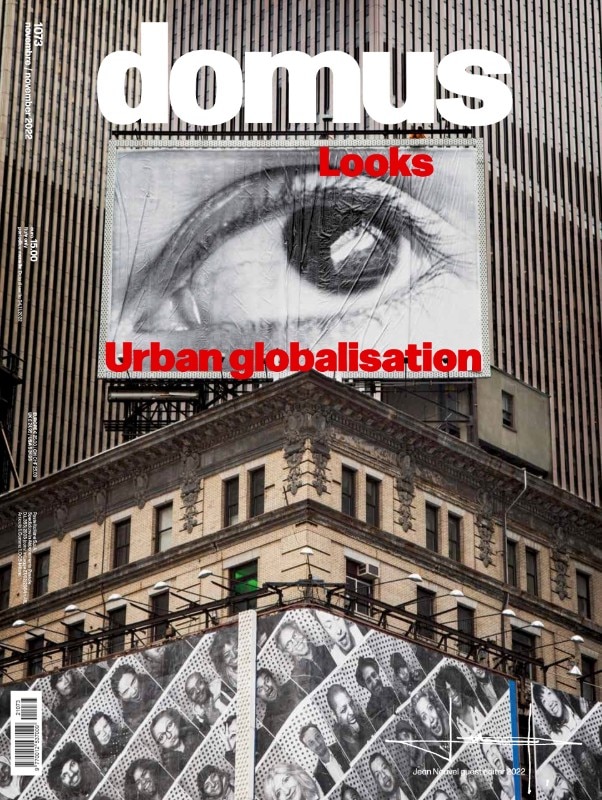The November issue of Domus, the latest edited by Guest Editor Jean Nouvel, focuses on urban globalization and its relationship with architecture. In his concluding Editorial, the French Pritzker Prize winner tackles the issue by writing about the right to live well that is being challenged by a world that is cloning itself. “Living well is fundamental to everyone’s life. It is the starting point: without a happy living space, nothing can prosper. Urban globalization is the result of selfishness with no awareness of the immediate future, of a general absence of empathy”. This is followed, again edited by Jean Nouvel, by a selection of fragments from the book Dériville by Bruce Bégout, an essay on the thought of Guy Debord and the imaginative work of the Situationists.
This is followed in the Essays by Tom Avermaete, Professor of the History and Theory of Urban Design at ETH Zurich, and Michelangelo Sabatino, Professor at the College of Architecture of the Illinois Institute of Technology in Chicago, tracing a history of the global in relation to architecture and the city. Next, Editorial Director Walter Mariotti discusses the path of a new deglobalization, a phenomenon that began shortly before the Covid-19 emergency, when many signs pointed to a change of course in global social and economic scenarios. “In the world of deglobalization, the introduction of cryptocurrencies has a paradoxical and contradictory effect.”
In the Homages section, we remember two figures from the international cultural scene who said goodbye to us this year: film director Jean-Luc Godard and philosopher and sociologist Bruno Latour. The Architecture section continues with an essay by the philosopher Edgar Morin, for whom City and Country are inextricably linked. Today, this relationship calls for a government of the territory that includes both in the same system. By leveraging solidarity and responsibility, then, we can recover what globalization has broken. Next, Jean Nouvel interviews French artist JR for Domus, tracing the genesis and stages of his project in the Tehachapi prison and reflecting on the positive aspects of globalization.
Writer and philosopher Bruce Bégout analyse the view of landscape, which has long oscillated between the picturesque and the sublime while recently appearing as a simple window on the ordinary world. Writer Nicolai Ouroussoff writes about architecture’s responses to the disasters caused by globalization in the urban sphere must pass through a vision of collective responsibility that opens up new creative possibilities. Jean-Louis Cohen, architect, and writer hypothesizes the presence of one city in another as one of the main symptoms of the relationship between global and local. A model of the migration of architectural forms from one scale to another that disrupts the usual opposition between the two poles. Architect Winy Maas writes about the hope for a more radical globalization, capable of bringing human beings closer to a solution: designing with, for and like nature. The section is closed by philologist Donatien Grau, according to whom to homologizing globalization there is an alternative that focuses on the sense of community and takes the archipelago as a theoretical and existential model.

The Art column opens with an essay by museum director Jean-Hubert Martin, dedicated to the elitist and competitive nature of contemporary Western art, which only apparently allows anyone freedom of expression. A journey in poetry by Syrian poet Adonis continues, accompanied by his graphic and illustrative works. For Design, Deyan Sudjic writes about British designer George Sowden, who for over ten years has decided to move production to China, following the industrial process himself. Although his studio is not multinational, the perspective adopted is decidedly global.
The issue closes with an article by Franco Raggi – former editor of Casabella and director of Modo – in which he articulates the typology of “middle-ground architecture”, capable of making itself visible in stages with measure and patience and renouncing the sharpness of catastrophic maintenance hyper-technologies. “An architecture that does not necessarily contain novelty as a trend, but renewal as a form of evolutionary thinking.”
This month’s Diario, pages dedicated to current affairs, is opened by the Points of View section, where James Stewart and Damiano Cerrone discuss the use of big-data in urban design: data is a great resource for designing better cities, how can it be applied to real cities and not just smart cities? Next, we remember the historic art director of Domus, who passed away last September, through his recent speech in Ascoli Piceno for the 40th anniversary of the Order of Architects. Alessandro Benetti writes about Lissoni Casal Ribeiro’s Shangri-La Shougang Park Hotel, which participates in the redevelopment of a former industrial site, functionalizing its large-scale architecture as spaces for hospitality. Silvana Annicchiarico examines the work of Olga Flór, an artist and designer from Eindhoven, who, with her project Under Cover has tried to bring comfort, warmth, and identity back into these standardized spaces. Axel Meise, founder and designer of Occhio, recounts its journey: from a German design icon to an international brand in the luxury segment.

Attached to this double issue, you will find the Contract issue, dedicated to new spaces for culture. The special issue opens with an editorial by Editorial Director Walter Mariotti, who explains the intention to bring together and in this process, both designers and companies, which remain the two sides of the change, not only to culture, but to lifestyles, in relation to the functions that the concept of culture must fulfill today, but also the ways in which culture is processed, experienced, consumed. Valentina Croci continues, writing about spectacular and multifunctional architecture but integrated into the historical, geographical, and social context. Cecilia Fabiani questions how museums are changing today and what it means to participate in projects and supplies in the field of cultural spaces.
Timeless icons: the Marenco sofa by arflex
Designed by Mario Marenco, this masterpiece of Italian design has set the standard for over fifty years.


























